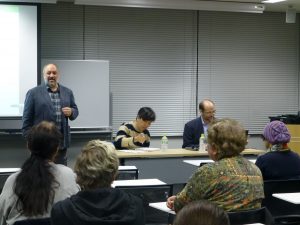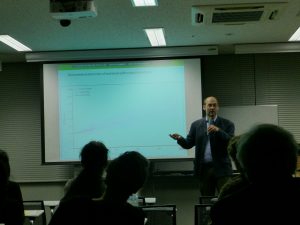講師 デイヴィッド・リチャードソン(ノースキャロライナ大学チャペルヒル校公衆衛生学部疫学科准教授)
広島平和研究所では、下記のとおりHPI研究フォーラムを開催しました。

1. テーマ
「原子力施設労働者国際共同研究(INWORKS)における労働者の固形がん死亡率」
2. 日時
2017年11月30日(木) 18:00-20:00
3. 場所
広島市中区大手町4-1-1大手町平和ビル9階(市役所本庁舎向い)
広島市立大学サテライトキャンパス セミナールーム2
4. 講演の概要
1943年マンハッタン計画の開始により、保健物理学の分野が登場し、電離放射線の健康への影響に関する研究が広がった。原子力施設労働者の被曝による健康への影響は、米国原子力委員会(AEC)の様々なメンバーにより異なる視点から考察された。戦時における核物質の生産と健康への影響に関する問題に関心を寄せ研究の焦点とした者は、直ちに明らかとなり、予後に重要となる明確な生物学的変化に目を向けた。他方で、長期的あるいは遺伝子的影響など、健康へのより一般的な放射線の影響の理解に関心を寄せる者もいた。
また、今日まで尾を引く業務執行上の利害関係に関する問題もある。マンハッタン工兵管区調査の医長スタフォード・ウォーレンは、訴訟や労働者への賠償要求が発生した場合の政府の利害を優位にするため健康調査を奨励した。こうした関心事から、原子力施設労働者に関する大規模な疫学的調査が行われることとなった。
1980年代の半ばより、原子力施設における労働者のがん罹患に関する文献が、主に米国と英国で多数出版された。個々の調査から発がん性リスクを推定することは、信頼区間(confidence intervals)が広いため確かではなく、放射線とがん罹患の明らかな関連はいくつかみられたものの、全ての解析コホート(対象集団)においてではなかった。複数の研究結果を要約し、統計的精度を向上するため、コホートの確保も引き続き行われた。
本フォーラムでは、原子力施設労働者国際共同研究(INWORKS)として知られる蓄積された調査の歴史を振り返り、直近で最大規模、そして最も有益な情報の多い分析結果について報告する。英・仏・米三カ国の原子力施設労働者308,297人について統合した調査研究であるため、ここでは、定量的結果が提示されるとともに、当該調査の長所と限界についても議論する。
5. 講師の略歴
1997年、ノースキャロライナ大学チャペルヒル校にて博士号取得(疫学)。主として、電離放射線被曝の健康への影響に関する研究をしている。米国エネルギー省の原子力施設労働者のがん調査のほか、広島・長崎の原爆投下により被爆した日本人生存者のがん調査も行っている。仏国リヨンにある世界保健機構の国際がん研究機関および広島にある放射線影響研究所にて客員研究員を務める。医学雑誌Occupational and Environmental MedicineおよびEnvironmental Health Perspectivesの副編集長を務めるほか、放射線と労働者の健康に関する大統領諮問機関のメンバーである。
HPI Research Forum on November 30, 2017
〝Solid cancer mortality among workers in the International Nuclear Workers Study (INWORKS)″
By David Richardson, Associate Professor of Epidemiology in the School of Public Health at the University of North Carolina at Chapel Hill
The Hiroshima Peace Institute held the HPI Research Forum as follows:
1. Topic “Solid cancer mortality among workers in the International Nuclear Workers Study (INWORKS)"
2. Lecturer
David Richardson, Associate Professor of Epidemiology in the School of Public Health at the University of North Carolina at Chapel Hill
3. Date and Time
November 30, 2017 (Thu.) 18:00-20:00
4. Venue
Seminar Room, Satellite Campus, Hiroshima City University
9F Otemachi Heiwa Building, 4-1-1 Otemachi, Nakaku, Hiroshima
5. Abstract of the Forum
The initiation of the Manhattan project in 1943 marked the emergence of the discipline of health physics and an expansion of research on the health effects of ionizing radiation. The health effects of occupational exposure to radiation were viewed from different perspectives by different members of the Atomic Energy Commission (AEC). There were those with immediate concerns and a focus on issues related to wartime production and health effects which were definite biological changes which are immediately evident or are of prognostic importance to health. Others had an interest in a more general understanding the effects of radiation on human health, including long term and genetic consequences. There were also managerial concerns, which persist today; Stafford Warren, medical director of the program, encouraged health research to help strengthen the government's interest in case of lawsuits or demands for workers' compensation. These concerns motivated a large scale epidemiological program of research on nuclear workers. Beginning in the mid-1980’s, numerous publications on cancer among workers at nuclear facilities appeared, mostly in the US and UK. Risk estimates from individual studies were uncertain, with wide confidence intervals; and, positive associations between radiation and cancer were observed in some, but not all cohorts. To summarize results across studies and improve statistical precision, pooling projects were undertaken. I will briefly review the history of these pooled studies and then present results from the most recent, largest, and most informative of these analyses, known as INWORKS. This is a combined study of 308,297 nuclear workers from the United Kingdom, France, and the United States of America. Quantitative results will be presented and the strengths and limitations of INWORKS will be discussed.
6. Profile of David Richardson
David Richardson earned his PhD from the Epidemiology in the School of Public Health at the University of North Carolina at Chapel Hill. His research focuses on the health effects of exposure to ionizing radiation. He has conducted studies of cancer among nuclear workers at several U.S. Department of Energy facilities, as well as studied cancer among the Japanese survivors of the atomic bombings of Hiroshima and Nagasaki. He has served as a visiting scientist at the World Health Organization’s International Agency for Research on Cancer in Lyon, France and at the Radiation Effects Research Foundation in Hiroshima, Japan. He is an Associate Editor of the journals Occupational and Environmental Medicine and Environmental Health Perspectives; and, he is a member of the President’s Advisory Board on Radiation and Worker Health.
